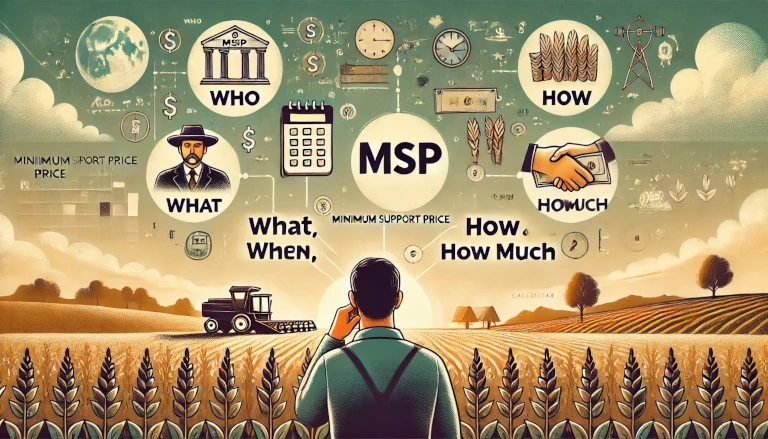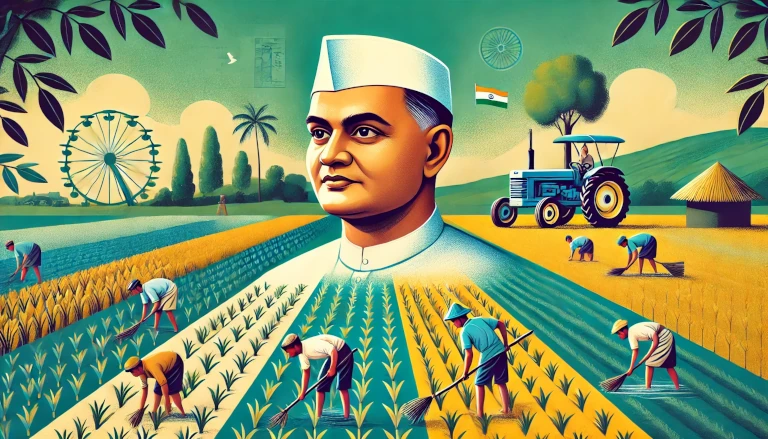Minimum Support Price (MSP) is a crucial topic in Indian agriculture, offering farmers an assured income for specific crops to protect them from market fluctuations. Below are 30 frequently asked questions about MSP, each answered to provide a clear understanding.
1. What is Minimum Support Price (MSP)?
MSP is a price set by the Indian government to protect farmers from market fluctuations, ensuring they receive a minimum income for their crops, even if market prices fall.
2. Who decides MSP in India?
The Commission for Agricultural Costs and Prices (CACP), under the Ministry of Agriculture, recommends MSP for key crops each season, which the government then announces.
3. Why was MSP introduced?
MSP was introduced in the 1960s to prevent farmers from financial loss due to unpredictable market prices and to encourage production of staple crops.
4. How is MSP calculated?
MSP is calculated based on production costs, which include inputs like seeds, labor, water, fertilizers, and a profit margin to ensure fair compensation for farmers.
5. What are the types of costs considered in MSP?
Costs include A2 (direct costs), A2+FL (family labor), and C2 (total costs including land rental and capital interest), with C2 providing the most comprehensive estimate.
6. How many crops are covered under MSP?
Currently, MSP is announced for 23 major crops, covering cereals, pulses, oilseeds, and commercial crops for both Kharif and Rabi seasons.
7. What is the difference between MSP for Kharif and Rabi crops?
Kharif crops, sown in the monsoon, include rice and maize, while Rabi crops, planted in winter, include wheat and barley. MSP differs based on season and crop type.
8. How does MSP benefit farmers?
MSP provides a safety net, ensuring farmers can recover production costs and earn a minimum profit, thus reducing financial risk and encouraging crop cultivation.
9. Why is MSP higher for certain crops?
MSP may be higher for crops essential for food security or for those with high production costs, like pulses and oilseeds, to promote their cultivation.
10. When is MSP announced?
MSP is announced twice a year, in June for Kharif crops and in October for Rabi crops, to guide farmers in crop selection before planting seasons.
11. What is C2 cost in MSP?
C2 cost includes A2+FL (direct costs and family labor) plus the cost of land rental and interest on invested capital, representing a more comprehensive production cost.
12. Does MSP cover all crops?
No, MSP only covers 23 specific crops to ensure essential food supply and support farmer income for major cereals, pulses, and oilseeds.
13. How does MSP impact consumer prices?
Higher MSP can lead to increased food prices if passed onto consumers, as the government buys crops at higher rates and supplies through distribution channels.
14. Can MSP lead to overproduction?
Yes, high MSPs can incentivize farmers to grow more of a particular crop, leading to overproduction and potential environmental strain, especially on water resources.
15. How does MSP affect inflation?
MSP can influence inflation by increasing prices for crops purchased at MSP. The impact on inflation is monitored to balance farmer and consumer needs.
16. What happens if market price is lower than MSP?
When market prices fall below MSP, the government buys the crops at MSP to protect farmers, preventing loss from lower market rates.
17. How is MSP different from procurement price?
While MSP is a minimum price guarantee, the procurement price is the actual price at which the government buys crops, which may be slightly higher or lower than MSP.
18. Can MSP be challenged politically?
Yes, MSP is a politically sensitive topic, with opposition parties often calling for increases or universal MSP for all crops, especially during election periods.
19. What are the challenges in implementing MSP?
Challenges include insufficient procurement infrastructure, varied costs across states, and limited MSP coverage in certain regions, affecting accessibility for all farmers.
20. Is MSP a subsidy?
MSP is not a subsidy; it’s a price floor ensuring minimum income for farmers. However, it does require government financial support to procure crops at MSP.
21. How does MSP impact crop diversity?
Higher MSP for specific crops, like rice and wheat, may discourage crop diversity, as farmers focus on profitable crops, sometimes leading to monocropping.
22. What’s the role of CACP in MSP?
The CACP analyzes production costs, market trends, and other factors to recommend MSP, aiming to balance farmer support with market stability.
23. Why are MSP prices different across states?
MSP prices are the same across India, but due to varying state support, farmers in states with strong procurement (like Punjab and Haryana) benefit more.
24. Can MSP reduce farmer suicides?
MSP can help alleviate financial stress by providing stable income, which may indirectly reduce economic distress contributing to farmer suicides.
25. What crops have the highest MSP?
Crops like pulses and oilseeds generally have higher MSP due to higher production costs and the government’s aim to promote nutritional crops.
26. Does MSP guarantee a buyer for all crops?
While MSP ensures a minimum price, procurement varies by crop and region. Not all crops covered by MSP are actively procured in all states.
27. What are the environmental implications of MSP?
High MSP for water-intensive crops can lead to resource strain, like groundwater depletion, as farmers might prioritize MSP crops over environmentally friendly options.
28. Can MSP be increased every year?
MSP can be adjusted annually, depending on inflation, input costs, and political considerations, to ensure it remains fair for farmers.
29. How does MSP relate to food security?
MSP incentivizes farmers to grow staple foods, ensuring a steady food supply, which contributes to the nation’s overall food security.
30. Are there alternatives to MSP?
Alternatives like market price support schemes, direct income support, and crop insurance are sometimes proposed as complementary or alternative ways to support farmers.
Read this in Marathi at किमान आधारभूत किंमत (MSP): प्रत्येक शेतकऱ्याला माहित असायला हवे असलेले सर्वकाही
Discover more from Green Ecosystem - Renewable Energy, Agriculture, and Environmental Sustainability
Subscribe to get the latest posts sent to your email.


